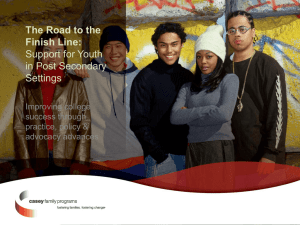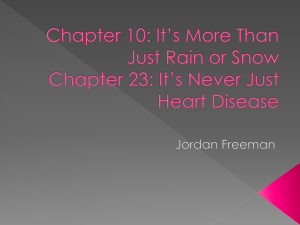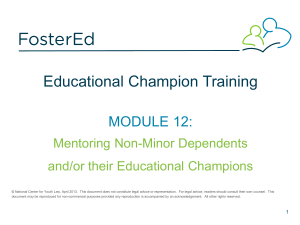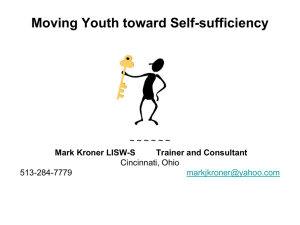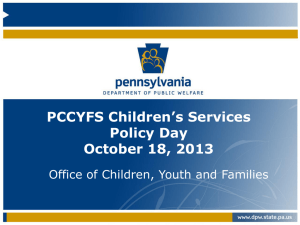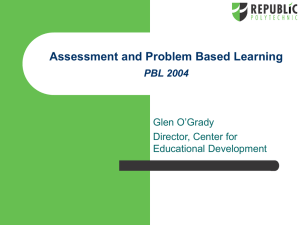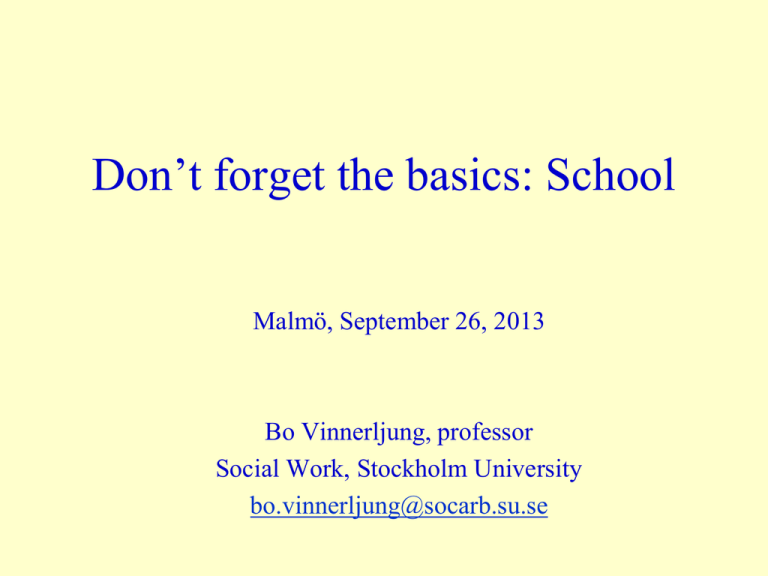
Don’t forget the basics: School
Malmö, September 26, 2013
Bo Vinnerljung, professor
Social Work, Stockholm University
bo.vinnerljung@socarb.su.se
Interdisciplinary research, eg.
•
•
•
•
•
•
•
Anders Hjern, pediatrics/epidemiology
Marie Berlin, sociology
Karl Gauffin, public health
Emma Björkenstam, epidemiology
Eva Tideman, psychology
Marie Sallnäs, social work
Bo Vinnerljung, social work
Anders Hjern
Menue
• Crash course in epidemiological analysis
• Results from national cohort studies based on
register data
• Results from intervention studies
• Relevance for work with anti-social adolescents
What is risk?
• Increased/reduced probability
– for something specific
– a relative concept
– a quantitative concept
For what?
Compared to whom/what?
How much?
• The comparison group has always Relative Risk (RR) = 1
• RR = 2 is 100% more
• RR >2-3 are high excess risks (“over-risks”)
• Risk does not say anything about “how many”
• 3% of all girls in Sweden become mothers before age 20
• 0,75% of all boys become fathers before age 20
• The risk of teenage parenthood is 4 times higher for girls
compared to boys (RR = 4)
To adjust for background factors
(confounders)
• “If the distribution of these background factors
were the same in the groups that we compare –
are there still any excess risks?”
• Examples: sex, parental education
• Adjustments are done in multivariate analyses:
each background factor’s unique association with
the outcome (”all other variables being equal”)
Nordic National registers
• Data bases covering the entire population. Purpose: statistics and
research.
• Individual data, based on a personal ID-number that follows every
resident from birth/immigration to death
• Each national register is regulated by law, Strict secrecy rules.
• All residents have a right to know the information about them in
the national registers but they do have the right to erase information
about themselves in the registers.
• Registers may be used/linked for research after approval from an
ethical board. Data are anonymized - individuals cannot be
identified.
• No cases of abuse or leaks.
Some medical national registers in the Nordic countries
Register
Denmark Finland Norway Sweden
Cause of
death
1943
1969
1951
1952
Medical
Birth
1973
1987
1967
1973
Hospital
discharge
1977
1987
2008
1987
Cancer
1943
1952
1952
1958
Prescribed
Drugs
1995
1995
2004
2005
Epidemiology, exploratory research
How many? Changes over time?
Who? Patterns of care? Care leavers experiences.
Prevalence of eg, mental and somatic health problems
Longitudinal studies
Risk factors, protective factors?
Risk mechanisms, mediators, moderators?
Clinical trials
Does school matter for all children
• .. in a longitudinal perspective?
• Yes, school performance is a powerful
predictor of future psychosocial problems
• …regardless of SES (socioeconomic
background, class), at least in Sweden
Grades: final year of primary school (age 16)
• Low/incomplete grades= lowest 1/6 in the country
< (M-1 SD)
• Compared to all the rest (5/6)
Suicide attempts
Per cent
16
14
Women
12
10
8
6
4
2
0
Manual
workers,
unskilled
Men
Per
16
14
12
10
8
6
4
2
0
Manuel
NonNonworkers,
manual
manuel
skilled employees, employees,
low/middle
high
Other
Low
Low/middle
Middle/high
High
Manual
workers,
unskilled
Manuel
NonNonworkers,
manual
manuel
skilled employees, employees,
low/middle
high
Other
SES for parents at age 10
Vinnerljung et al, 2010
Links between childhood factors
and drug abuse after age 20
• All born in Sweden 1973-88, alive at age 16
• N=1,4 million. Follow-up to 2008 (age 20-35).
• Indication of drug abuse
–
–
–
–
Drug related death or
Hospitalization with drug abuse diagnosis (not intox) or
Convicted for drug related crime
3% (42.000)
Gauffin et al, 2012
Background factor
RR
(all else being equal)
Mother’s SES
--
Mother born outside Europa
1,7
Mother single
1,5
Mother a teenage mother
--
Mother did not work
--
Mother disability pension
--
Mother lived on welfare
1,4
Mother serious mental health problems
1,3
Father serious mental health problems
--
Mother substance abuse
1,4
Father substance abuse
1,6
Mother substantial criminality
1,3
Father substantial criminality
1,5
Grew up in a city vs in a rural community
1,7
Man (sex)
2,4
No/incomplete/very low school grades at age 16
4,1
Poor grades/school performance
have links to eg.
• Low cognitive capacity (0.65 with IQ at conscription)
• Other individual traits, eg. working memory
• Behavioral problems – but this is not a one-way street
• Mental health problems
• Poor support from home, adverse childhood etc
• School related factors, poor peer status in school
What does this mean for
children in societal care?
They do poorly in school
Social services do a poor job with their
school/education (but not SiS)
School failure is added to other risk factors
National cohort study/register data
• Analyses of datasets with all born 1972-1981.
Linking 10 national registers.
• Follow-up from age 16 to 2005 (age 24-33)
– 930.000 persons, including
– 7.000 children that grew up in foster care,
average time in care 12 years
Vinnerljung et al, 2010; Berlin et al, 2011
No/incomplete/low grades Above average
Boys
Normal group
In home care before teens
Children from welfare families
Grown up in foster care
22%
55%
57%
60%
41%
15%
13%
11%
11%
37%
40%
43%
60%
27%
25%
23%
Girls
Normal group
In home care before teens
Children from welfare families
Grown up in foster care
Grown up in foster care: > 5 years in care (M= 11 years in care), left care after
age 17. All persons with disability pension at age 23 were excluded from the
analysis
What factors increase the risk for poor
grades among foster children?
•
•
•
•
•
•
•
•
Sex/gender
Birth year
Age at placement
Time in care
Mother mental health problems
Mother substance abuse
Father mental health problems
Far substance abuse
***
--------
Negative expectations...
• Results from trials suggest that social workers, teachers
and foster parents commonly
– underestimate the cognitive capacity of foster children
– have pessimistic expectations of school performance
• Same results in Danish and British studies
Foster children: Five-fold disadvantaged by
the care and education system
•
•
•
•
High risks of school failure
Lower grades than peers with same IQ
Lower education than peers with same IQ
Lower education than peers with same grades
• Lower chances of secondary education if they
had poor grades (eg. fewer use adult education)
Children growing up in foster care have high risks
for future…
•
•
•
•
•
•
•
•
Suicide
Suicide attempts
Serious mental health problems
Drug abuse
Alcohol abuse
Serious criminality
Teenage parenthood
Welfare dependency
RR = 6.4
RR = 6.2
RR = 5.0
RR = 6.8
RR = 4.9
RR = 7.5
RR = 3.8
RR = 9.8
(adjusted for sex and birth year)
Long term foster care: Drug abuse after age 20
7
6
RR
5
4
3
2
1
Normal
Adj for sex
Also for
and birth school failure
year
Long term foster care:
serious criminality after age 20
8
7
6
RR
5
4
3
2
1
Normal
Adj for sex &
Also for
birth year school failure
Analyses of foster children only
• No/low grades the only substantial risk factor for all
negative outcomes (except sex)
• Parental pathology no/weak association with outcomes
• No associations between age at placement or time in care
• Abscence of school failure the only strong factor that
predicted good outcomes (except gender)
– regardless of how ”good outcome” was defined
Conclusions
• Children who fail at school are a high risk group for future
psychosocial problems – regardless of socioeconomic background
• School failure seems to be the strongest risk mechanism for foster
children’s long term development (same for other children from the
social marginal)
• A determinant for foster children’s future
• The good news: school performance is a variable risk factor .
(in contrast to sex, age, genes, experiences from early childhood etc)
The Helsingborg trial - SkolFam
• 25 foster children age 7-12 were tested with standardized
psychological and educational instruments
• Results were used to
– access available support from school
– tailor individual educational support and interventions
– advice teachers/schools, foster parents - and the children
• This was done by an educational psychologist and a
special education teacher.
• Re-tests after 24 months to evaluate the program
Results after first measurements
• Normal cognitive capacity (average lower than peers, same as
international adoptees).
• 75% were substantially underachieving in school
• Large knowledge gaps were common
• Most foster parents, social workers and teachers had
low/pessimistic expectations on the children’s school performance.
• Lots of pseudo-psychological explanations to why the children did
poorly in school
• Pathologizing of children was common, “amateur diagnoses”
Results after 2 years
“Clinical knowledge” says that the foster children’s school
performance should have deteriorated (larger gaps over
time between them and normal population peers)
• Wisc IQ Total
• Wisc IQ Performance
• Wisc IQ Verbal
***
**
*
• Spelling (DLS)
• Reading speed
• Word Chains
*
*
*
• Magne’s Math diagnosis
n.s.
(p<0,001)
(p<0,01)
(p< 0,05)
Tideman et al, 2011
Replication in Norrköping 2008-11
• 21 children, two years between tests
• Working memory training was added for children with
poor numeracy skills
• WISC – same results as in Helsingborg
• Literacy – similar results to Helsingborg
• But Maths….
Tordön et al, submitted
Math scores related to working memory training
Without WM training
With WM training
Total
Case study – Jens, age 11
At start of intervention:
• Personal assistent in school, concentration problems,
suspected ADHD, suspected learning disability
• IK 70, working memory 62 (WISC)
• Maths, stanine 1
• Working memory training
• Re-start in math
After two years:
• IK 86 (+23%) , working memory 99 (+60 %)
• Math stanine 5
• No concentration problems
• Likes school
Paired Reading trial
• We trained foster parents to use a special reading
tecnique for 80 children age 8-12
• Reading 20 min/day, 3 days/week
• 16 weeks (pre-post evaluation, std instruments)
• Replication of a English trial
Results
• The average child increased her/his reading age
with almost a year (11 months), after 4 months of
Paired Reading ( in England 12 months)
• Improved scores on the WISC vocabulary scale
Improved Total IQ
Interventions younger children
+
School perform
‒
Anti-soc behavior
‒
Anti-soc behavior
+
School perform
----------------------------------------------------------------Interventions anti-social adolescents
‒
Anti-soc behavior
+ School perform
+
School perform
? Anti-soc behavior
Does improved literacy/numeracy skills have
a value, even if this is not related to reduced
anti-social behavior in the short run?
Yes – it increases the chance that youth can
benefit from turning points later in life
(hypothesis).
Turning points
• Far more decisive than treatment
• Examples: partner, parenthood, getting tired of
crime/substance abuse, health concerns, getting a
job, religon
• Today, inclusion in the labor market usually
requires school/education (learning a trade)
• The way out,”the escape from disadvantage”.
What to do?
• A minimum standard for school/education in
residential care for anti-social adolsecents
• At least…
– Assessment of literacy and numeracy skills
– Identify knowledge gaps in maths, re-start
– Start literacy and numeracy training, high quality
programs (evidence based methods).
– Cognitive tests for assessing potential - but….
Results from cognitive tests (IQ)
of children from the social marginal
are often instable, and may change over time
References
•
•
•
•
•
•
•
Jablonska B, Lindberg L, Lindblad F, Rasmussen F, Östberg V & Hjern A (2009)
School performance and hospital admissions due to self-inflicted injuries. Int Journal
of Epidemiology, 38, 1334-1341.
Björkenstam C, Björkenstam E, Ljung R, Vinnerljung B & Tuvblad C (2013). Suicidal
behavior among delinquent former child welfare clients. European Child & Adolescent
Psychiatry, 22, 349-355.
Tideman E, Vinnerljung B, Hintze K & Isaksson AA (2011). Improving foster
children’s school achievements: Promising results from a Swedish intensive study.
Adoption & Fostering, 35, 44-56.
Berlin M, Vinnerljung B & Hjern A (2011). School performance in primary school
and psychosocial problems in young adulthood among care leavers from long term
foster care. Children and Youth Services Review, 33, 2489-2487.
Vinnerljung B & Hjern A (2011). Cognitive, educational and self-support outcomes of
long-term foster care versus adoption. A Swedish national cohort study. Children and
Youth Services Review, 33, 1902-1910.
Forsman H & Vinnerljung B (2012) Interventions aiming to improve school
achievements of children in out-of-home care: a scoping review. Children and Youth
Services Review. 34, 1084-1091.
Gauffin K, Vinnerljung B, Fridell M, Hesse M & Hjern A (2013). Childhood
socioeconomic status, school failure, and drug abuse – a Swedish national cohort
study. Addiction, 108, 1441-1449.


